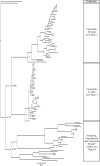Pursuing the quest for better understanding the taxonomic distribution of the system of doubly uniparental inheritance of mtDNA
- PMID: 27994972
- PMCID: PMC5157197
- DOI: 10.7717/peerj.2760
Pursuing the quest for better understanding the taxonomic distribution of the system of doubly uniparental inheritance of mtDNA
Abstract
There is only one exception to strict maternal inheritance of mitochondrial DNA (mtDNA) in the animal kingdom: a system named doubly uniparental inheritance (DUI), which is found in several bivalve species. Why and how such a radically different system of mitochondrial transmission evolved in bivalve remains obscure. Obtaining a more complete taxonomic distribution of DUI in the Bivalvia may help to better understand its origin and function. In this study we provide evidence for the presence of sex-linked heteroplasmy (thus the possible presence of DUI) in two bivalve species, i.e., the nuculanoid Yoldia hyperborea(Gould, 1841)and the veneroid Scrobicularia plana(Da Costa,1778), increasing the number of families in which DUI has been found by two. An update on the taxonomic distribution of DUI in the Bivalvia is also presented.
Keywords: Bivalvia; Doubly uniparental inheritance; Mitochondrial DNA; Mitochondrial inheritance; Scrobicularia plana; Yoldia hyperborea.
Conflict of interest statement
The authors declare there are no competing interests.
Figures




References
-
- Alves FA, Beasley CR, Hoeh WR, Da Rocha RM, De Simone LR, Tagliaro CH. Detection of mitochondrial DNA heteroplasmy suggests a doubly uniparental inheritance pattern in the mussel Mytella charruana. Revista Brasileira de Biociências. 2012;10(2):176–185.
-
- Bieler R, Mikkelsen PM. Bivalvia—a look at the branches. Zoological Journal of the Linnean Society. 2006;148:223–235. doi: 10.1111/j.1096-3642.2006.00255.x. - DOI
-
- Birky CW. The inheritance of genes in mitochondria and chloroplasts: laws, mechanisms, and models. Annual Review of Genetics. 2001;35:125–148. - PubMed
-
- BivAToL: Assembling the Bivalve Tree of Life. 2007. http://www.bivatol.org/index.php/the-project. [21 July 2016]. http://www.bivatol.org/index.php/the-project
LinkOut - more resources
Full Text Sources
Other Literature Sources

